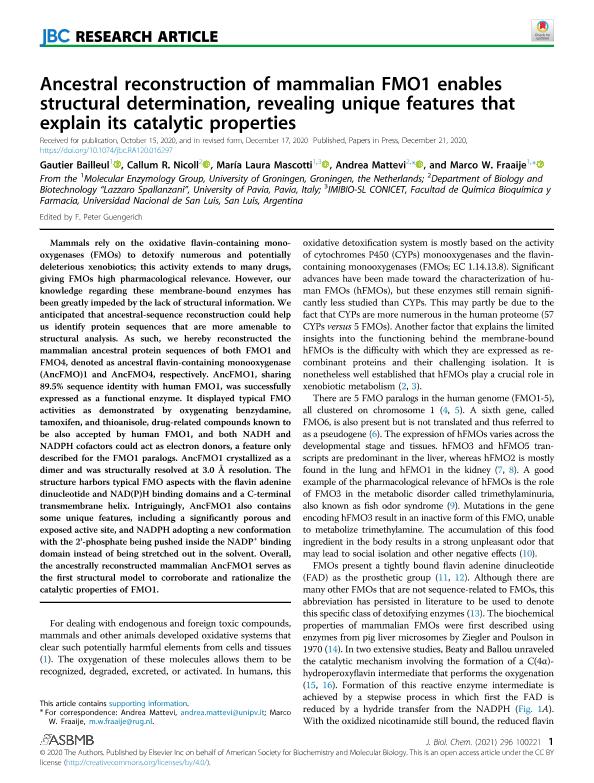Artículo
Ancestral reconstruction of mammalian FMO1 enables structural determination, revealing unique features that explain its catalytic properties
Bailleul, Gautier; Nicoll, Callum R.; Mascotti, María Laura ; Mattevi, Andrea; Fraaije, Marco Wilhelmus
; Mattevi, Andrea; Fraaije, Marco Wilhelmus
 ; Mattevi, Andrea; Fraaije, Marco Wilhelmus
; Mattevi, Andrea; Fraaije, Marco Wilhelmus
Fecha de publicación:
01/2021
Editorial:
American Society for Biochemistry and Molecular Biology
Revista:
Journal of Biological Chemistry (online)
ISSN:
0021-9258
Idioma:
Inglés
Tipo de recurso:
Artículo publicado
Clasificación temática:
Resumen
Mammals rely on the oxidative flavin-containing monooxygenases (FMOs) to detoxify numerous and potentially deleterious xenobiotics; this activity extends to many drugs, giving FMOs high pharmacological relevance. However, our knowledge regarding these membrane-bound enzymes has been greatly impeded by the lack of structural information. We anticipated that ancestral-sequence reconstruction could help us identify protein sequences that are more amenable to structural analysis. As such, we hereby reconstructed the mammalian ancestral protein sequences of both FMO1 and FMO4, denoted as ancestral flavin-containing monooxygenase (AncFMO)1 and AncFMO4, respectively. AncFMO1, sharing 89.5% sequence identity with human FMO1, was successfully expressed as a functional enzyme. It displayed typical FMO activities as demonstrated by oxygenating benzydamine, tamoxifen, and thioanisole, drug-related compounds known to be also accepted by human FMO1, and both NADH and NADPH cofactors could act as electron donors, a feature only described for the FMO1 paralogs. AncFMO1 crystallized as a dimer and was structurally resolved at 3.0 Å resolution. The structure harbors typical FMO aspects with the flavin adenine dinucleotide and NAD(P)H binding domains and a C-terminal transmembrane helix. Intriguingly, AncFMO1 also contains some unique features, including a significantly porous and exposed active site, and NADPH adopting a new conformation with the 2’-phosphate being pushed inside the NADP+ binding domain instead of being stretched out in the solvent. Overall, the ancestrally reconstructed mammalian AncFMO1 serves as the first structural model to corroborate and rationalize the catalytic properties of FMO1.
Archivos asociados
Licencia
Identificadores
Colecciones
Articulos(IMIBIO-SL)
Articulos de INST. MULTIDICIPLINARIO DE INV. BIO. DE SAN LUIS
Articulos de INST. MULTIDICIPLINARIO DE INV. BIO. DE SAN LUIS
Citación
Bailleul, Gautier; Nicoll, Callum R.; Mascotti, María Laura; Mattevi, Andrea; Fraaije, Marco Wilhelmus; Ancestral reconstruction of mammalian FMO1 enables structural determination, revealing unique features that explain its catalytic properties; American Society for Biochemistry and Molecular Biology; Journal of Biological Chemistry (online); 296; 1-2021; 1-13
Compartir
Altmétricas



